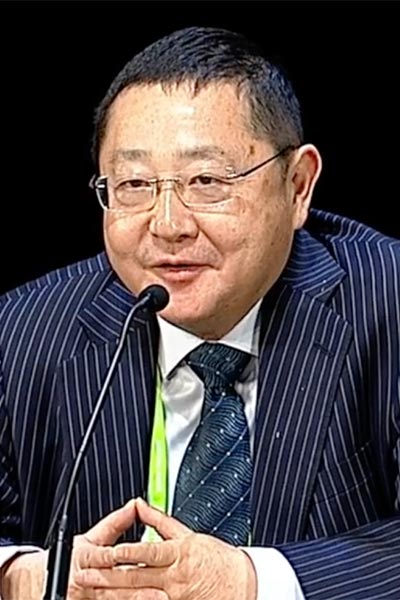Third Clinical Trials Plenary Session highlights new targeted therapies for non-small cell lung cancer
On Monday, clinical researchers at the AACR Annual Meeting 2025 presented their data during the third Clinical Trials Plenary Session, focused exclusively on new targeted therapies for non-small cell lung cancer (NSCLC).
Lung cancer is the leading cause of cancer death in the United States, with an estimated 124,730 people expected to die of the disease in 2025. NSCLC is the most common type of lung cancer, accounting for up to 85% of lung cancer cases.
In 2024, the United States saw a flurry of regulatory approvals for targeted therapies for NSCLC, including several new indications for drugs that target the epidermal growth factor receptor (EGFR). However, researchers still face challenges associated with overcoming resistance to EGFR inhibitors, improving existing options for other therapeutic options in NSCLC, and finding ways to target cancer drivers without existing drugs.
In Monday’s Clinical Trials Plenary Session, Therapeutic Advances in Non-small Cell Lung Cancer, researchers discussed data from four new targeted therapies being tested in NSCLC patients, including inhibitors of HER2, TIGIT, ROS1, and EGFR.
Beamion LUNG-1: Oral HER2-targeted therapy zongertinib in previously treated patients

While 2% to 4% of NSCLC tumors are driven by mutations in the human epidermal growth factor receptor 2 (HER2), the only HER2-targeted therapy approved by the U.S. Food and Drug Administration (FDA) for NSCLC is the antibody-drug conjugate (ADC) trastuzumab deruxtecan (T-DXd; Enhertu), which is not effective in all patients, must be delivered intravenously, and may cause significant side effects. Existing HER2 small molecule inhibitors can also cause serious side effects due to their cross-targeting of EGFR, explained John V. Heymach, MD, PhD, from The University of Texas MD Anderson Cancer Center.
“There remains a clear unmet need for a potent tyrosine kinase inhibitor that selectively inhibits HER2 while sparing these EGFR-related toxicities,” Heymach said.
Heymach and colleagues tested a novel HER2 small molecule inhibitor, zongertinib, in patients with HER2-mutated NSCLC that had been previously treated with at least one prior line of therapy in the first-in-human phase I Beamion LUNG-1 clinical trial. Their primary analysis cohort consisted of 75 patients whose tumors harbored mutations in the tyrosine kinase domain of HER2. Among these patients, 71% of patients had an objective response to zongertinib with a median response duration of 14.1 months, and 17% of patients experienced grade 3 or higher adverse events.
Heymach and colleagues also assessed outcomes in exploratory cohorts of patients whose tumors had HER2 mutations outside the tyrosine kinase domain and patients who previously received a HER2-targeted ADC; responses were observed in these cohorts as well, and zongertinib was well tolerated, Heymach noted.
SKYSCRAPER-01: Targeting TIGIT no better than standard of care
Immune checkpoint inhibitors (ICIs) have transformed the treatment landscape of several solid tumors, including NSCLC, and researchers have persistently sought to expand the therapies available in this area. TIGIT is an immune checkpoint that, thus far, has not had an inhibitor reach regulatory approval.

Data from a phase II clinical trial suggested that the TIGIT-targeted antibody tiragolumab, in combination with the PD-L1 inhibitor atezolizumab, may benefit patients with previously untreated NSCLC expressing high levels of PD-L1. Solange Peters, MD, PhD, from Lausanne University Hospital, and colleagues performed the phase III SKYSCRAPER-01 trial to test this hypothesis in a larger patient population.
The researchers randomly assigned (1:1) patients to receive tiragolumab plus atezolizumab or placebo plus atezolizumab. In the efficacy-evaluable population of 266 patients in the tiragolumab arm and 268 patients in the placebo arm, the progression-free survival was 7 months and 5.6 months, respectively. The median overall survival was 23.1 months in the tiragolumab arm and 16.9 months in the placebo arm. Neither difference was statistically significant. Further, more overall adverse events and more adverse events leading to treatment discontinuation were observed in the tiragolumab arm.
Peters remains hopeful that further refining the patient population will better define a group of patients who will benefit from TIGIT-targeted therapy. “I’m convinced that further data … are needed to identify the patient population who potentially could benefit from combining an anti-PD-1 or anti-PD-L1 strategy with the inhibition of the TIGIT pathway,” she said.
New ROS1 inhibitor may overcome resistance mutations

Several ROS1 inhibitors are currently approved to treat NSCLC tumors that harbor ROS1 fusions. However, treatment resistance is a common problem, often mediated by the ROS1 G2032R resistance mutation. Further, many patients develop brain metastases, and existing ROS1 inhibitors have a limited ability to cross the blood-brain barrier, according to Hongyun Zhao, PhD, from the Sun Yat-sen University Cancer Center.
The novel ROS1 inhibitor JYP0322 was designed to cross the blood-brain barrier and to overcome the ROS1 G2032R resistance mutation. Zhao and colleagues tested the safety and efficacy of JYP0322 in a phase I clinical trial in which they enrolled 81 patients with previously treated, locally advanced or metastatic ROS1 fusion-positive NSCLC. Of note, 71.6% of patients had been previously treated with ROS1 inhibitors, and 42% had metastases to the nervous system at baseline.
The objective response rate was 78.9% in patients who had not received previous ROS1 inhibitors and 57.4% in patients who were previously treated with ROS1 inhibitors. Among patients with brain metastases, the intracranial objective response rate was 42.9%, and the intracranial disease control rate was 73.5%. Zhao noted that the observed concentration of JYP0322 in the intracranial space was higher than that reported in trials of other ROS1 inhibitors.
“Based on this, we think JYP0322 may have significant potential in treating ROS1-fusion NSCLC with brain metastasis,” Zhao said.
AENEAS2: Aumolertinib plus chemotherapy for EGFR-mutated locally advanced or metastatic disease
EGFR is one of the most commonly mutated genes in NSCLC, with seven targeted therapies currently approved by the FDA for use in the United States. While the tyrosine kinase inhibitor aumolertinib is not among them, it is approved in China for the first-line treatment of patients with locally advanced or metastatic NSCLC that harbors an exon 19 deletion or L858R mutation in the EGFR gene.

Researchers in China—including Shun Lu, MD, PhD, from Shanghai Chest Hospital, who presented the study—sought to determine whether adding chemotherapy to aumolertinib could improve its efficacy. They enrolled 624 patients with previously untreated locally advanced or metastatic NSCLC characterized by an exon 19 deletion or L858R mutation and randomly assigned patients (1:1) to receive aumolertinib alone or with chemotherapy.
Patients who received the combination had a median progression-free survival of 28.9 months, compared with 18.9 months among patients who received aumolertinib alone. The median overall survival has not been reached in either arm. Progression-free survival benefit was observed regardless of the type of EGFR mutation and in patients with and without brain metastases.
“Aumolertinib combined with platinum-pemetrexed has demonstrated a statistically significant and clinically meaningful improvement in progression-free survival,” said Zhao. “Aumolertinib plus chemotherapy offers a new first-line treatment option for patients with locally advanced or metastatic EGFR-mutated NSCLC.”
More from the AACR Annual Meeting 2025
View a photo gallery of scenes from Chicago, continue the conversation on social media using the hashtag #AACR25, and read more coverage in AACR Annual Meeting News.

